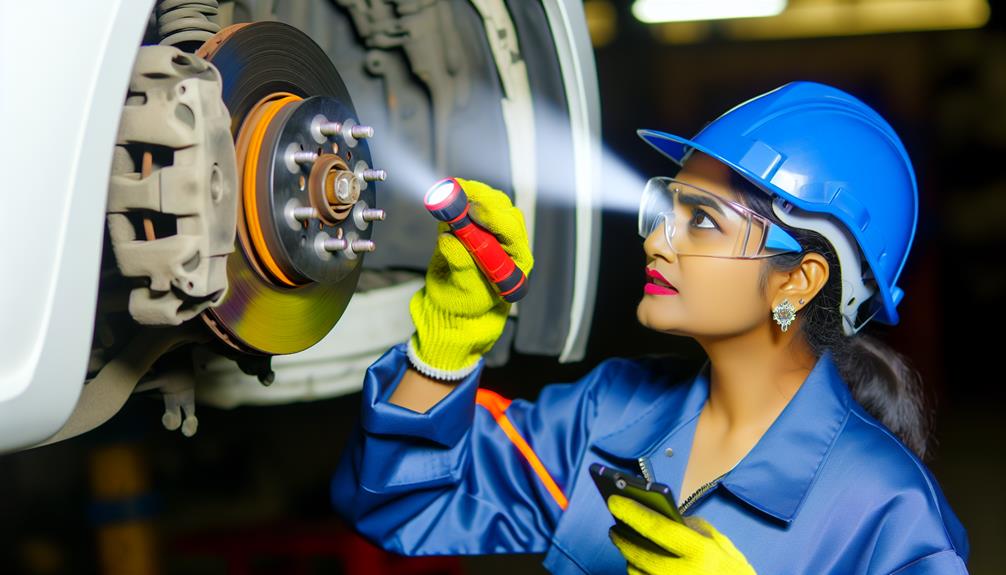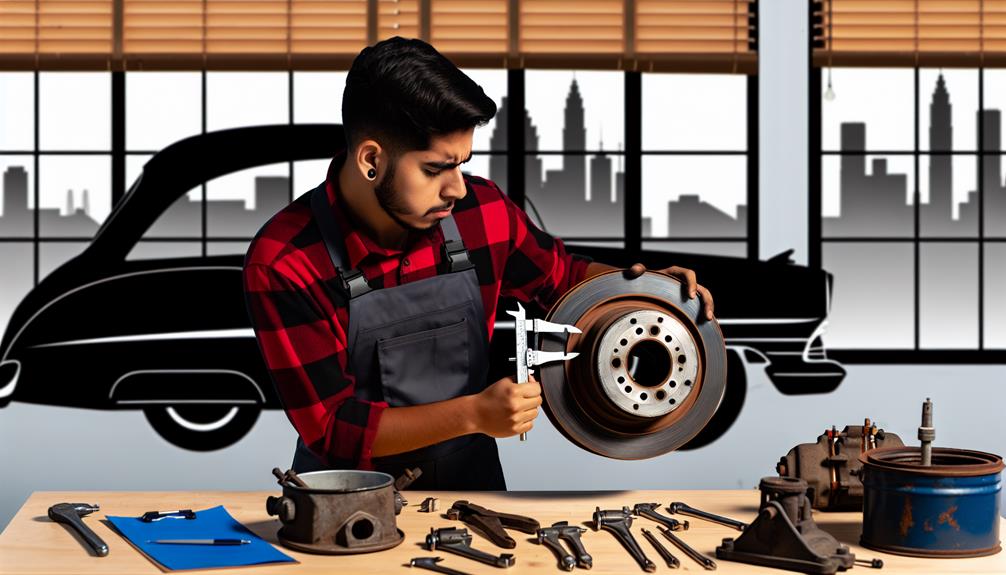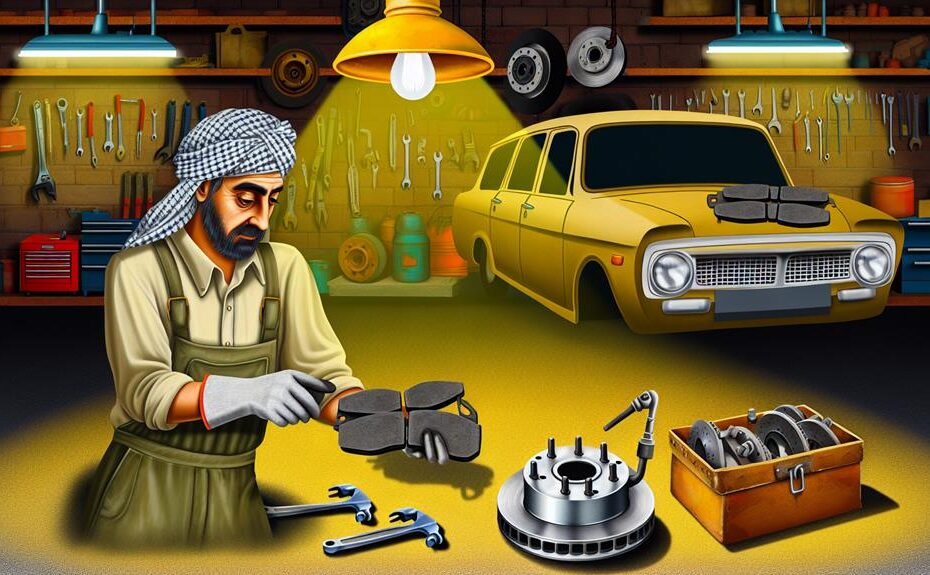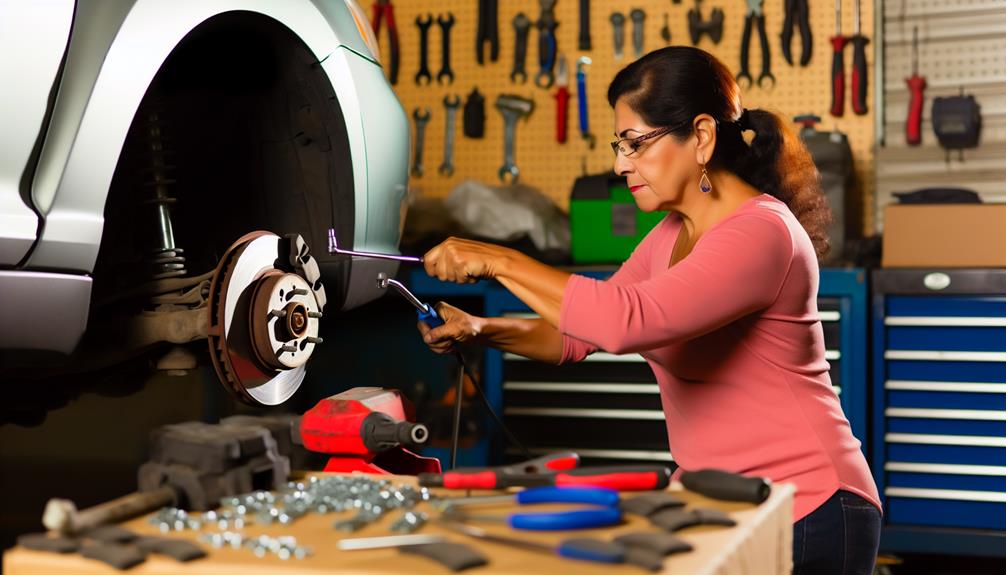You love the timeless beauty and charm of classic cars. The way they turn heads as they glide down the street, effortlessly blending the old and the new.
But amidst the allure of these vintage vehicles lies a crucial aspect that demands your attention – the brakes.
While the nostalgia may be intoxicating, it's important to remember that classic cars require proper maintenance to ensure safety on the road.
So, whether you're a seasoned classic car enthusiast or a newbie to the world of vintage automobiles, this essential brake repair guide will provide you with the knowledge and tools necessary to keep your classic car's stopping power in top shape.
Key Takeaways
- The brake system of classic cars consists of four main components: master cylinder, brake lines, brake calipers or wheel cylinders, and brake pads or shoes.
- Signs of brake wear in vintage cars include squeaking or squealing noises, pulsating brake pedal, reduced braking effectiveness, and longer stopping distance.
- Common brake issues in vintage cars include brake fade, brake fluid leakage, and limited stopping power compared to modern vehicles.
- Regular brake inspection, maintenance, and the use of essential tools like a brake bleeding kit and brake shoe replacement kit are crucial for optimal braking performance in classic cars.
Understanding Classic Car Brakes
To fully comprehend classic car brakes, you need to delve into their intricate mechanics and grasp their essential components. Classic car brake systems differ from modern ones in various ways. Understanding these differences is crucial for maintaining and restoring vintage vehicles.
Classic car brake systems typically consist of four main components: the master cylinder, brake lines, brake calipers or wheel cylinders, and brake pads or shoes. The master cylinder, usually located under the hood, is responsible for generating hydraulic pressure that activates the brakes. Brake lines, made of metal or flexible rubber, transport the hydraulic fluid from the master cylinder to the brake calipers or wheel cylinders. These calipers or cylinders, attached to the wheels, exert pressure on the brake pads or shoes, which in turn create friction against the brake rotors or drums to slow down or stop the vehicle.
When it comes to signs of brake wear in vintage cars, there are a few key indicators to look out for. These include squeaking or squealing noises when applying the brakes, a pulsating brake pedal, reduced braking effectiveness, and a longer stopping distance. It's important to address these signs promptly, as worn brakes can compromise the safety of both the driver and the vehicle.
Common Brake Issues in Vintage Cars
Vintage cars often experience a range of common brake issues due to the age and unique characteristics of their brake systems. When it comes to classic car brake restoration, it's important to be aware of these issues and take the necessary steps to fix them.
One common problem in vintage cars is brake fade. This occurs when the brakes lose their effectiveness due to overheating. To address this issue, you can consider upgrading to a modern braking system or installing larger brake drums and shoes.
Another issue that vintage car owners often face is brake fluid leakage. Over time, the brake lines and hoses may become corroded or damaged, leading to fluid leaks. Regularly inspecting the brake lines and hoses and replacing them when necessary is crucial to maintain a safe braking system.
Additionally, vintage cars may have limited stopping power compared to modern vehicles. To improve the braking performance, you can consider installing power brake boosters or upgrading to disc brakes.
Step-by-Step Brake Inspection Process

Start by preparing your classic car for the brake inspection process. Ensure that the car is parked on a level surface and the engine is turned off. Here is a step-by-step guide to help you inspect your brakes with precision:
- Remove the wheels: Loosen the lug nuts and lift the car using a jack. Remove the wheels to gain access to the braking system.
- Inspect the brake pads: Examine the thickness of the brake pads. If they're less than 1/8 inch thick, it's time for a brake pad replacement. Look for uneven wear, cracking, or glazing on the pads.
- Check the brake drums: Inspect the surface of the brake drums for any signs of grooves, cracks, or excessive wear. Measure the diameter of the drums using a micrometer to ensure they're within the manufacturer's specifications.
- Inspect the brake lines: Check the brake lines for any signs of leakage, corrosion, or damage. Ensure that the lines are properly secured and there are no loose connections.
- Check the brake fluid: Examine the brake fluid level in the master cylinder reservoir. If it's below the recommended level, top it up with the appropriate brake fluid.
Essential Tools for Classic Brake Repair
After completing a thorough brake inspection on your classic car, it's important to have the essential tools necessary for a successful brake repair. Two crucial tools for brake repair are a brake bleeding kit and a brake shoe replacement kit.
The brake bleeding process is essential to ensure that there are no air bubbles in the brake lines, which can affect the braking performance. A brake bleeding kit typically includes a brake bleeder valve, a brake fluid reservoir, and a hose. This kit allows you to effectively bleed the brakes and remove any air trapped within the system.
Another essential tool for classic brake repair is a brake shoe replacement kit. This kit includes everything you need to replace worn-out brake shoes, such as new brake shoes, springs, and clips. It's important to regularly inspect and replace brake shoes to maintain optimal braking performance and ensure your safety on the road.
With the right tools, you can easily remove the old brake shoes and install the new ones, ensuring that your braking system is in top condition.
Having these essential tools on hand will empower you to confidently tackle any brake repair job on your classic car. Remember to always follow proper safety procedures and consult a professional if you're unsure about any aspect of the brake repair process.
Tips for Maintaining Classic Car Brakes

To effectively maintain the brakes on your classic car, it's crucial to implement a regular maintenance routine. By following a few simple tips, you can ensure that your vintage car brakes remain in optimal condition for years to come.
- Inspect and Clean: Regularly inspect your classic car brakes for any signs of wear or damage. Clean the brake components thoroughly to remove any dirt or debris that may have accumulated.
- Adjust Brake Pads: Check the brake pad thickness and adjust them if necessary. Worn-out or improperly adjusted brake pads can affect the braking performance of your classic car.
- Preserve Brake Fluid: Monitor the level and condition of the brake fluid. Classic cars often have non-standard brake systems, so it's essential to use the correct type of brake fluid specified by the manufacturer.
- Regularly Bleed Brakes: Over time, air can get trapped in the brake lines, affecting brake performance. Regularly bleeding the brakes will remove any air bubbles and ensure optimal brake function.
- Inspect Brake Lines: Inspect the brake lines for any signs of corrosion or damage. Replace any worn-out or damaged brake lines to maintain the integrity of your classic car brake system.
Frequently Asked Questions
How Often Should I Replace the Brake Fluid in My Classic Car?
You should replace the brake fluid in your classic car every two years to ensure proper brake function. Neglecting brake fluid maintenance can lead to decreased braking performance and potential safety hazards.
Can I Use Modern Brake Pads on My Vintage Car?
Yes, you can use modern brake pads on your vintage car. Upgrading your brakes with modern pads can greatly improve vintage car safety, providing better stopping power and reducing the risk of brake failure.
Are There Any Specific Brake Maintenance Tasks That Are Unique to Classic Cars?
Maintaining classic car brakes requires unique techniques. From adjusting drum brakes to bleeding the system, there's a level of craftsmanship involved. Just like a skilled artist, you must delicately balance safety and preservation, ensuring your vintage ride remains liberated on the road.
What Are the Signs of Brake System Failure in a Vintage Car?
If you're experiencing issues with your vintage car brake system, it's crucial to identify the signs of brake failure. Look out for warning signs such as decreased stopping power, squealing or grinding noises, and a spongy or low brake pedal.
Is It Possible to Upgrade the Braking System on a Classic Car for Better Performance and Safety?
Yes, you can upgrade the braking system on a classic car for better performance and safety. By installing modern disc brakes, upgrading brake lines, and adding a brake booster, your classic car will have improved stopping power and responsiveness.
Conclusion
So there you have it, a comprehensive guide to brake repair for your classic car. By following these steps and utilizing the essential tools, you can ensure the safety and longevity of your vehicle's brakes.
Some may argue that modern cars are easier to maintain, but there's nothing quite like the satisfaction of working on a vintage beauty.
Remember, with patience and expertise, you can conquer any brake issue that comes your way.
Happy restoring!


